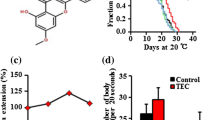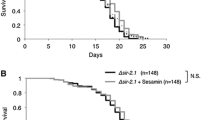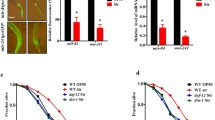Abstract
The nematode Caenorhabditis elegans responds to flavonoid-rich diets with improved health and longevity. The precise mechanism(s) responsible for this remains to be identified, but is believed to be linked to the highly antioxidative properties of flavonoids. This study provides a dissection of lifespan modulation by the flavonoid quercetin. In detail, quercetin was shown not to act as a simple antimicrobial agent or exclusively via radical scavenging capacities. Likewise, lifespan extension had no effect on reproduction and body length. Furthermore, neither a caloric restriction mimetic nor a sirtuin (sir-2.1) dependence was identified as a likely mode of action. However, four genes were pinpointed to be required for the quercetin derived lifespan extension, namely age-1, daf-2, unc-43 and sek-1. The latter two have, to date, not been linked to quercetin-mediated lifespan extension.






Similar content being viewed by others
References
An JH, Blackwell TK (2003) SKN-1 links C. elegans mesodermal specification to conserved oxidative stress response. Genes Dev 17:1882–1893. doi:10.1101/gad.1107803
Antebi A (2007) Genetics of aging in Caenorhabditis elegans. PLoS Genet 3:1565–1571. doi:10.1371/journal.pgen.0030129
Baumeister R, Schaffitzel E, Hertweck M (2006) Endocrine signaling in Caenorhabditis elegans controls stress response and longevity. J Endocrinol 190:191–202. doi:10.1677/joe.1.06856
Berdichevsky A, Viswanathan M, Horvitz HR, Guarente L (2006) C. elegans SIR-2.1 interacts with 14-3-3 proteins to activate DAF-16 and extend lifespan. Cell 125:1165–1177. doi:10.1016/j.cell.2006.04.036
Bishop NA, Guarente L (2007) Genetic links between diet and lifespan: shared mechanisms from yeast to humans. Nat Rev Genet 8:835–844. doi:10.1038/nrg2188
Brenner S (1974) The genetics of Caenorhabditis elegans. Genetics 77:71–94
Brown MK, Evans JL, Luo Y (2006) Beneficial effects of natural antioxidants EGCG and alpha-lipoic acid on lifespan and age-dependent behavioural declines in Caenorhabditis elegans. Pharmacol Biochem Behav 85:620–628. doi:10.1016/j.pbb.2006.10.017
Chávez V, Mohri-Shiomi A, Maadani A, Vega LA (2007) Oxidative stress enzymes are required for DAF-16-mediated immunity due to generation of reactive oxygen species by Caenorhabditis elegans. Genetics 176:1567–1577. doi:10.1534/genetics.107.072587
Chen D, Guarente L (2007) SIR2: a potential target for calorie restriction mimetics. Trends Mol Med 13(2):64–71. doi:10.1016/j.molmed.2006.12.004
Delgado G, del Socorro Olivares M, Chavez MI, Ramirez-Apan T, Linares E, Bye R, Espinosa-Garcia FJ (2001) Anti-inflammatory constituents from Heterotheca inuloides. J Nat Prod 64:861–864. doi:10.1021/np0005107
Friedman DB, Johnson TE (1988) A mutation in the age-1 gene in Caenorhabditis elegans lengthens life and reduces hermaphrodite fertility. Genetics 118:7–86
Garigan D, Hsu AL, Fraser AG, Kamath RS, Ahringer J, Kenyon C (2002) Genetic analysis of tissue aging in Caenorhabditis elegans: a role for heat-shock factor and bacterial proliferation. Genetics 161:1101–1112
Gatto MT, Falcocchio S, Grippa E, Mazzanti G, Battinelli L, Nicolosi G, Lambusta D, Saso L (2002) Antimicrobial and anti-lipase activity of quercetin and its C2–C16 3-O-acyl-esters. Bioorg Med Chem 10:269–272. doi:10.1016/S0968-0896(01)00275-9
Gems D, Riddle DL (2000) Genetic, behavioural and environmental determinants of male longevity in Caenorhabditis elegans. Genetics 154:1597–1610
Gerisch B, Rottiers V, Li D, Motola DL, Cummins CL, Lehrach H, Mangelsdorf DJ, Antebi A (2007) A bile-like steroid modulates Caenorhabditis elegans lifespan through nuclear receptor signaling. Proc Natl Acad Sci USA 104:5014–5019. doi:10.1073/pnas.0700847104
Greer EL, Brunet A (2008) Signalling networks in aging. J Cell Sci 121:407–412. doi:10.1242/jcs.021519
Gruber J, Tang SY, Halliwell AB (2007) Evidence for a trade-off between survival and fitness caused by resveratrol treatment of Caenorhabditis elegans. Ann N Y Acad Sci 1100:530–542. doi:10.1196/annals.1395.059
Guarente L (2008) Mitochondria—a nexus for aging, calorie restriction, and sitruins? Cell 132:171–176. doi:10.1016/j.cell.2008.01.007
Henderson ST, Bonafe M, Johnson TE (2006) daf-16 protects the nematode Caenorhabditis elegans during food deprivation. J Gerontol A Biol Sci Med Sci 61:444–460
Hertweck M, Christine G, Baumeister R (2004) C. elegans SGK-1 is the critical component in the Akt/PKB kinase complex to control stress response and lifespan. Dev Cell 6:577–588. doi:10.1016/S1534-5807(04)00095-4
Holliday R (1989) Food, reproduction and longevity: is the extended lifespan of calorie-restricted animals an evolutionary adaption? Bioessays 10:125–127. doi:10.1002/bies.950100408
Houthoofd K, Vanfleteren JR (2006) The longevity effect of dietary restriction in Caenorhabditis elegans. Exp Gerontol 41:1026–1031. doi:10.1016/j.exger.2006.05.007
Ingram DK, Zhu M, Mamczarz J, Zou S, Lane MA, Roth GS, de Cabo R (2006) Calorie restriction mimetics: an emerging research field. Aging Cell 5:97–108. doi:10.1111/j.1474-9726.2006.00202.x
Inoue H, Hisamoto N, An JH, Oliveira RP, Nishida E, Blackwell TK, Matsumoto K (2005) The C. elegans p38 MAPK pathway regulates nuclear localization of the transcription factor SKN-1 in oxidative stress response. Genes Dev 1:2278–2283. doi:10.1101/gad.1324805
Ishii N, Michikhiko F, Hartman PS, Tsuda M, Yasuda K, Senoo-Matsuda N, Yanase S, Ayusawa D, Suzuki K (1998) A mutation in succinate dehydrogenase cytochrome b causes oxidative stress and aging in nematodes. Nature 394:694–697. doi:10.1038/29331
Joseph J, Shukitt-Hale B, Casadesus G (2005) Reversing the deleterious effects of aging on neuronal communications and behaviour: beneficial properties of fruit polyphenolic compounds. Am J Clin Nutr 81(Suppl.):313S–316S
Joseph J, Shukitt-Hale B, Denisova N, Bielinski D, Martin A, McElwen J, Bickford P (1999) Reversals of age-related declines in neuronal signal transduction, cognitive and motor behavioural deficits with blueberry, spinach or strawberry dietary supplementation. J Neurosci 19:8114–8121
Kaeberlein TL, Smith ED, Tsuchiya M, Welton KL, Thomas JH, Fields S, Kennedy BK, Kaeberlein M (2006) Lifespan extension in Caenorhabditis elegans by complete removal of food. Aging Cell 5:487–494. doi:10.1111/j.1474-9726.2006.00238.x
Kampkötter A, Nkwonkam CG, Zurawski RF, Timpel C, Chovolou Y, Wätjen W, Kahl R (2007a) Effects of the flavonoids kaemperol and fisetin on thermotolerance, oxidative stress and FoxO transcription factor DAF-16 in the model organism Caenorhabditis elegans. Arch Toxicol 81:849–858. doi:10.1007/s00204-007-0215-4
Kampkötter A, Nkwonkam CG, Zurawski RF, Timpel C, Chovolou Y, Wätjen W, Kahl R (2007b) Investigations of protective effects of the flavonoids quercetin and rutin on stress resistance the in model organism Caenorhabditis elegans. Toxicology 234:113–123. doi:10.1016/j.tox.2007.02.006
Kampkötter A, Timpel C, Zurawski RF, Ruhl S, Chovolou Y, Proksch P, Wätjen W (2008) Increase of stress resistance and lifespan of Caenorhabditis elegans by quercetin. Comp Biochem Physiol Part B 149:314–323
Kenyon C (2005) The plasticity of aging: insights from long-lived mutants. Cell 120:449–460. doi:10.1016/j.cell.2005.02.002
Kenyon C, Chang J, Gensch E, Rudner A, Tabtiang R (1993) A C. elegans mutant that lives twice as long as wild type. Nature 366:461–664. doi:10.1038/366461a0
Kim DH, Feinbaum R, Alloing G, Emerson FE, Garsin DA, Inoue H, Tanaka-Hino M, Hisamoto N, Matsumoto K, Tan MW, Ausubel FM (2002) A conserved p38 MAP kinase pathway in Caenorhabditis elegans innate immunity. Science 297:623–626. doi:10.1126/science.1073759
Kirkwood TB (1977) Evolution of ageing. Nature 270:301–304. doi:10.1038/270301a0
Kirkwood TB (1988) The nature and causes of ageing. Ciba Found Symp 134:193–207
Kirkwood TB (2005) Understanding the odd science of aging. Cell 120:437–447. doi:10.1016/j.cell.2005.01.027
Kirkwood TB (2008a) A systematic look at an old problem. Nature 451:644–647. doi:10.1038/451644a
Kirkwood TB (2008b) Understanding aging from an evolutionary perspective. J Intern Med 263:117–127
Kondo M, Yanase S, Ishii T, Hartman PS, Matsumo K, Ishii N (2005) The p38 signal transduction pathway participates in the oxidative stress mediated translocation of DAF-16 to Caenorhabditis nuclei. Mech Ageing Dev 126:642–647. doi:10.1016/j.mad.2004.11.012
Kong AN, Yu R, Chen C, Mandlekar S, Primiano T (2000) Signal transduction events elicited by natural products: role of MAPK and caspase pathways in homeostatic response and induction of apoptosis. Arch Pharm Res 23:1–16. doi:10.1007/BF02976458
Lee KW, Lee HJ (2006) The roles of polyphenols in cancer chemoprevention. Biofactors 26:105–121
Lindblom TH, Pierce GJ, Sluder AE (2001) A C. elegans orphan receptor contributes to xenobiotic resistance. Curr Biol 11:864–868. doi:10.1016/S0960-9822(01)00236-6
Mamani-Matsuda M, Rambert J, Malvy D, Lejoly-Boisseau H, Daulouéde S, Thiolat D, Coves S, Courtois P, Vincendeau P, Mossalayi MD (2004) Quercetin induces apoptosis of Trypanosoma bruci gambiense and decreases proinflammatory response of human marcrophages. Antimicrob Agents Chemother 48:924–929. doi:10.1128/AAC.48.3.924-929.2004
Manach C, Scalbert A, Morand C, Rémésy C, Jimenez L (2004) Polyphenols: food sources and bioavailability. Am J Clin Nutr 79:727–747
Manach C, Williamson G, Morand C, Scalbert A, Rémésy C (2005) Bioavailability and bioefficacy of polyphenols in humans. I. Review of 97 bioavailability studies. Am J Clin Nutr 81(Suppl.):230S–242S
Martin B, Golden E, Carlson OD, Egan JM, Mattson MP, Maudsley S (2008) Caloric restriction: impact upon pituitary function and reproduction. Ageing Res Rev 7:209–224. doi:10.1016/j.arr.2008.01.002
Matter WF, Brown RF, Vlahos CJ (1992) The inhibition of phosphatidylinositol 3-kinase by quercetin and analogs. Biochem Biophys Res Commun 186:624–631. doi:10.1016/0006-291X(92)90792-J
McCay CM, Crowell MF, Maynard LA (1935) The effect of retarded growth upon the length of life and upon the ultimate body size. J Nutr 10:63–79
Millet ACM, Ewbank JJ (2004) Immunity in Caenorhabditis elegans. Curr Opin Immunol 16:4–9. doi:10.1016/j.coi.2003.11.005
Murphy MP, Patridge L (2008) Toward a control theory analysis of aging. Annu Rev Biochem 77:777–798. doi:10.1146/annurev.biochem.77.070606.101605
Nielsen IL, Dragsted LO, Ravn-Haren G, Freese R, Rasmussen SE (2003) Absorption and excretion of black currant anthocyanins in humans and Watanabe heritable hyperlipidemic rabbits. J Agric Food Chem 51:2813–2820. doi:10.1021/jf025947u
Patridge L, Gems D (2007) Benchmarks for ageing studies. Nature 450:165–167. doi:10.1038/450165a
Piper MD, Selman C, McElwee JJ, Patridge L (2008) Separating cause from effect: how does insulin/IGF signalling control lifespan in worms, flies and mice? J Intern Med 263:179–191
Rechner AR, Kuhnle G, Hu H et al (2002) The metabolism of dietary polyphenols and the relevance to circulating levels of conjugated metabolites. Free Radic Res 36:1229–1241
Reiner DJ, Newton EM, Tian H, Thomas JH (1999) Diverse behavioural defects caused by mutations in Caenorhabditis elegans unc-43 CaM kinase II. Nature 402:199–203. doi:10.1038/46072
Sagasti A, Hisamoto N, Hyodo J, Tanaka-Hino M, Matsumoto K, Bargmann CI (2001) The CaMKII UNC-43 activates the MAPKKK NSY-1 to execute a lateral signaling decision required for asymmetric olfactory neuron fates. Cell 105:221–232. doi:10.1016/S0092-8674(01)00313-0
Saul N, Pietsch K, Menzel R, Steinberg CEW (2008) Quercetin-mediated longevity in Caenorhabditis elegans: is DAF-16 involved? Mech Ageing Dev 129:611–613. doi:10.1016/j.mad.2008.07.001
Schroeter H, Spencer JP, Rice-Evans C, Williams RJ (2001) Flavonoids protect neurons from oxidized low-density-lipoprotein-induced apoptosis involving c-Jun N-terminal kinase (JNK), c-Jun and caspase-3. Biochem J 358:547–557. doi:10.1042/0264-6021:3580547
Solomon A, Bandhakavi S, Jabbar S, Shah R, Beitel GJ, Morimoto RI (2004) Caenorhabditis elegans OSR-1 regulates behavioral and physiological responses to hyperosmotic environments. Genetics 167:161–170. doi:10.1534/genetics.167.1.161
Spencer JPE, Rice-Evans C, Williams RJ (2003) Modulation of pro-survival Akt/PKB and ERK1/2 signalling cascades by quercetin and its in vivo metabolites underlie their action on neuronal viability. J Biol Chem 278:34783–34793
Steinberg CEW, Saul N, Pietsch K, Meinelt T, Rienau S, Menzel R (2007) Dissolved humic substances facilitate fish life in extreme aquatic environments and have the potential to extend the lifespan of Caenorhabditis elegans. Ann Environ Sci 1:81–90
Tissenbaum HA, Guarente L (2001) Increased dosage of a sir-2 gene extends lifespan in Caenorhabditis elegans. Nature 410:227–230. doi:10.1038/35065638
Tullet JM, Hertweck M, An JH, Baker J, Hwang JY, Liu S, Oliveira RP, Baumeister R, Blackwell TK (2008) Direct inhibition of the longevity-promoting factor SKN-1 by insulin-like signaling in C. elegans. Cell 132:1025–1038. doi:10.1016/j.cell.2008.01.030
Wiegant FA, Surinova S, Ytsma E, Langelaar-Makkinje M, Wikman G, Post JA (2008) Plant adaptogens increase lifespan and stress resistance in C. elegans. Biogerontology. doi:10.1007/s10522-008-9151-9
Williams RJ, Spencer JPE, Rice-Evans C (2004) Flavonoids: antioxidants or signalling molecules? Free Radic Biol Med 36:838–849. doi:10.1016/j.freeradbiomed.2004.01.001
Wilson MA, Shukitt-Hale B, Kalt W, Ingram DK, Joseph JA, Wolkow CA (2006) Blueberry polyphenols increase lifespan and thermotolerance in Caenorhabditis elegans. Aging Cell 5:59–68. doi:10.1111/j.1474-9726.2006.00192.x
Wolf M, Nunes F, Henkel A, Heinick A, Paul RJ (2008) The MAP kinase JNK-1 Caenorhabditis elegans: location, activation, and influences over temperature-dependent insulin-like signaling, stress response, and fitness. J Cell Physiol 214:721–729. doi:10.1002/jcp.21269
Wood JG, Rogina B, Lavu S, Howitz K, Helfand SL, Tatar M, Sinclair D (2004) Sirtuin activators mimic caloric restriction and delay ageing in metazoans. Nature 430:686–689. doi:10.1038/nature02789
Wu Z, Smith JV, Paramasivam V, Butko P, Khan I, Cypser JR, Luo Y (2002) Ginko bilboa extract EGb761 increases stress resistance and extends lifespan of Caenorhabditis elegans. Cell Mol Biol 48:725–731
Young JAT, Dillin A (2004) MAPping innate immunity. Proc Natl Acad Sci USA 31:12781–12782. doi:10.1073/pnas.0404890101
Zimniak P (2008) Detoxification reactions: relevance to aging. Ageing Res Rev 7:281–300. doi:10.1016/j.arr.2008.04.001
Acknowledgments
We thank the Caenorhabditis Genetic Centre, which is funded by the National Institutes of Health National Centre for Research Resources, for supplying wild type and mutant strains.
Author information
Authors and Affiliations
Corresponding author
Electronic supplementary material
Below is the link to the electronic supplementary material.
10522_2008_9199_MOESM1_ESM.doc
Supplementary Table 1 Median and maximum lifespan of untreated control compared to quercetin treated wild type C. elegans (statistical significance was calculated using the mean values presented in Table 1) (DOC 46 kb)
10522_2008_9199_MOESM2_ESM.doc
Supplementary Table 2 Median and maximum lifespan from wild type and mutant C. elegans, either in the presence or absence of 200 µM quercetin (statistical significance was calculated using the mean values presented in Table 2) (DOC 44 kb)
Rights and permissions
About this article
Cite this article
Pietsch, K., Saul, N., Menzel, R. et al. Quercetin mediated lifespan extension in Caenorhabditis elegans is modulated by age-1, daf-2, sek-1 and unc-43 . Biogerontology 10, 565–578 (2009). https://doi.org/10.1007/s10522-008-9199-6
Received:
Accepted:
Published:
Issue Date:
DOI: https://doi.org/10.1007/s10522-008-9199-6





